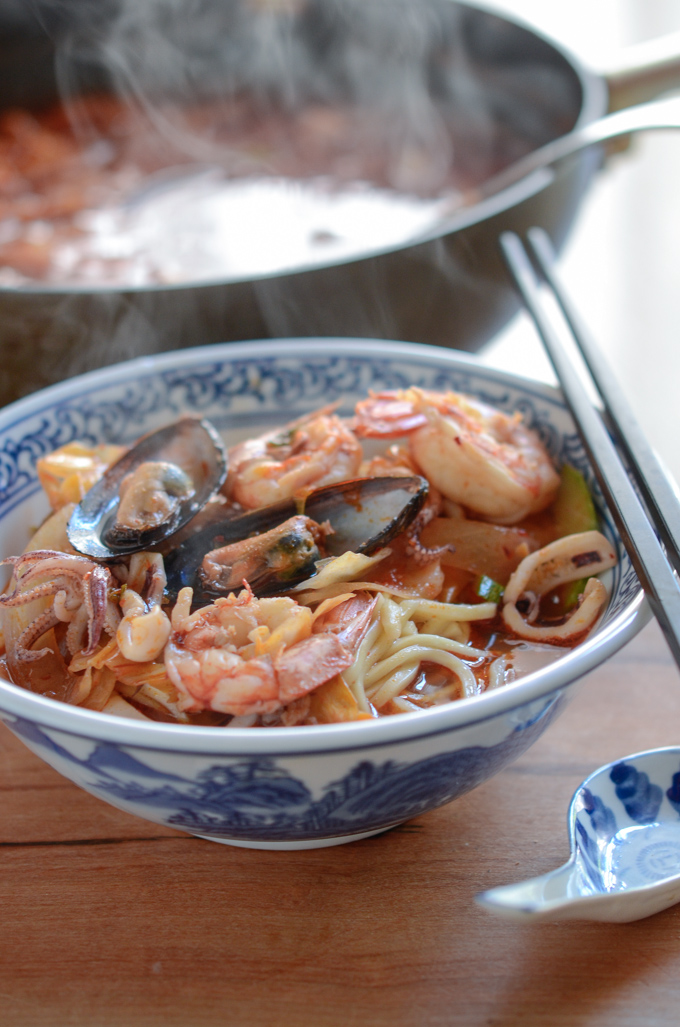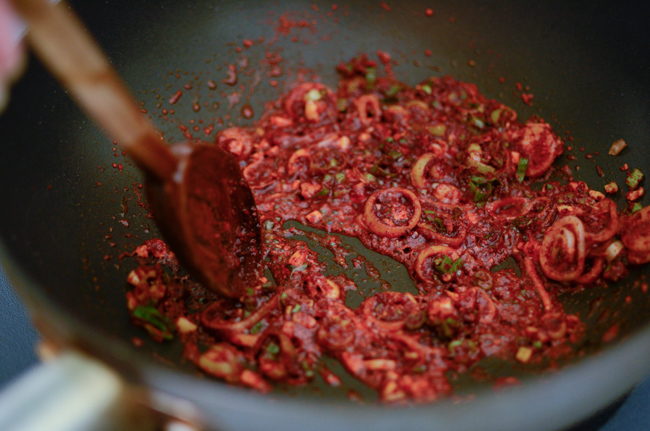Jjamppong Recipe (Korean Seafood Noodle Soup)
Jjamppong is spicy Korean seafood noodle soup. Try this classic jjamppong recipe at home to replicate the popular Korean-Chinese dish. It’s easier than you think. Use a variety of seafood for a better tasting and satisfying soup.

There are two majorly popular Chinese inspired Korean foods: Jjajangmyeon (짜장면) and spicy Korean seafood noodle soup called Jjamppong (짬뽕). If you go to any Korean-Chinese restaurants, you will always find these two items on the menu for sure.
When the weather outside is chilly and dreary, Korean people often order this spicy seafood noodle soup from their local restaurant as a delivery.
Yes, Korea is a heaven an earth when it comes to the food delivery. Anything can be delivered anywhere, anytime. I miss the convenient life style in Korea, which is hard to find in the country I am currently living in.
Jjamppong is also easy to replicate at home. Everybody has a different way of making it. So I am adding my version to the list. You will love the outcome.
Recipe Notes
1. Use Variety of Seafood

I picked squid (calamari), shrimp, and mussels. Use at least 2-3 different types to get a good flavor in the soup. If you don’t like squid, then use scallops instead.
- If you don’t like seafood at all, then this jjamppong recipe obviously not the right dish for you. But I am telling you, this is one heck of good noodle soup that you shouldn’t miss if you love spicy soup and seafood.
If you want to see how to clean fresh squid, check my Korean stir-fried squid recipe to get an idea. It can be yucky, but fun to try at least once in your lifetime.
2. Try with chicken stock as a soup base
chicken stock adds rich flavor to this seafood soup. I found it better than anchovy stock. Either store-bought or homemade, chicken stock will work and you will love the taste.
3. Fresh wheat noodles brings better taste and texture
It’s best to use freshly wheat noodles, but if you can’t, try with fresh pasta. The texture and the taste of fresh noodles make a difference. However, dried wheat noodles will work fine if you can’t find neither of them.

I have to tell you that it is not easy to find fresh seafood in the suburbs of Buenos Aires. I wanted to make this Jjamppong for a long time but couldn’t do it because of the unavailability of ingredients.
So when my local seafood seller stocked squid (calamari), shrimp, and mussels the other day, I knew I had to grab some before they sold out. Once they sold out, I might have to wait another few months to see them again.
How to make Jjamppong

Slice green cabbage, zucchini, and onions. You will also need to chop leeks (or green onion), and garlic.

First, saute the leeks (green onion) and garlic in oil until soft.
Some people like to add a little amount of pork in the soup. If you want to do so, stir-fry the pork at this stage. Pork will add another layer of flavor in the soup.

Add the Korean chili flakes. Yes, 3 tablespoons!
It seems like an awfully large amount of chili but this is meant to be intensively red and spicy. Actually you will be surprised that the outcome is not overly spicy like you think. This soup is NOT going to numb your senses. I promise.
If you want an extra heat to knock yourself out, add some cayenne pepper. That will bring a plenty of extra heat to the soup. This might help relieve cold symptoms like nasal congestion. It always helped me.

Add the cabbage and onion and continue to saute until they are softened, about 2-3 minutes.

Add the zucchini slices and cook 1 more minute, then add the chicken stock (I recommend to use low sodium). Add the oyster sauce to the soup, mix and bring the whole thing to a boil.

Simmer for a few minutes. When the vegetables are soft and tender, add the seafood. Season with Korean soy sauce for soup. Adjust the seasoning according to your taste. Now, your Korean spicy seafood noodle soup (Jjamppong) is ready to serve.

Prepare wheat noodles according to your package’s directions and place individual servings in bowls. If you can’t find Asian style wheat noodles, use spaghetti noodles instead.

Ladle the hot soup over the noodles.

Take a moment to stare at the beauty for 2 seconds first, to show a respect to the chef. Then start slurping the noodles. Don’t forget the spicy broth. Unless you added the cayenne pepper, it is not overly spicy as you would think.
You’re gonna love this, folks! I devoured the entire bowl of soup in less than 5 minutes. So delicious!
Leftover Jjamppong soup storage
The leftover jjamppong soup reheats very well. Do not mix with noodles before you store. Store the soup in the fridge and reheat on the stove top. Serve with freshly cooked noodles or over rice.
More Noodle Recipes
- Quick Sesame Soba Noodles
- Naengmyeon, Korean style spicy cold noodles
- Korean Noodles with Beef Sauce
- One Pot Korean Noodles and Vegetables

Jjamppong Recipe (Korean Seafood Noodle Soup)
Ingredients
- 3 tbsp oil
- 1 leek , or 3 green onion, chopped
- 3 garlic cloves, chopped
- 1/3 lb pork loin, thinly sliced, optional
- 3 tbsp Korean chili flakes (gochugaru)
- 1 tsp cayenne pepper, optional
- 1/4 green cabbage, sliced
- 1 onion, sliced
- 1 zucchini, sliced
- 4 cup low sodium chicken broth
- 1 cup water
- 2 tbsp oyster sauce
- 1-2 tbsp Korean soup soy sauce (gukganjang)
- freshly ground pepper , to taste
- 1 1/2 – 2 lb variety of seafood; shrimp,squid (calamrai), mussel, cleaned, shelled, or sliced
- Wheat noodles , or spaghetti noodles
Instructions
- In a large pot (a wok is a good option to use), heat oil over med-high heat and saute leek (or green onion) and garlic until fragrant. Add the pork, if using, to fry with the garlic mixture.
- Add the chili flakes and stir-fry for 1 minute. Be careful not to burn the pepper. Add cayenne pepper if you desire extreme heat.
- Add the cabbage and onion to the chili mixture and coat them well. Continue to stir-fry until wilted, about 2-3 minutes. Add the zucchini slices and fry 1 more minute.
- Pour the chicken broth and water and bring them to boil. Add the oyster sauce to the soup, and continue to simmer until the vegetables are tender over medium heat, about 3-5 minutes.
- Add the seafood, season with Korean soy sauce for soup and pepper according to your taste.
- Meanwhile, prepare the noodles according to the package directions. Distribute the noodles into the individual bowls. Ladle the hot soup over the noodles and serve immediately.
Notes



There’s an instant Jjampon noodles that I’m craazy for here. Seeing your version makes me want the authentic thing!
I heard there were many new instant jjamppong noodles. I can’t wait to try the instant version when I can get hold of them. I heard many good reviews.
This soup looks so very comfy and delicious, Holly! My husband would just love this! Thanks for this awesome share!
OMG Holly this looks so very delicious. I am going to look for this in a restaurant
Yes, if you like seafood, this soup is full of flavor. Hope you get to try soon.
This soup looks heavenly! I love how much seafood is in it!
I love seafood and I can’t get enough of them. With the flavorful broth, this noodle soup hits my spot!
I love any and all noodle dishes! Seafood ones are particularly nice. And spicy ones? Best of all! Obviously you were thinking of me when you made this!
Great to hear that, John! I will think of you next time I make this soup again, LOL!